|
1.
CENTRAL AND WEST AFRICA
Regional round-up
The recent up-tick in some sawnwood prices can be
attributed primarily to a change in Chinese purchasing
patterns with furniture manufacturers opting for more cost-
effective timbers such as okoume and ayous. As a result
there has been decline in demand for more expensive
species like ovangkol, bubinga (Kevazingo) and tali
resulting in weakening prices.
Chinese furniture manufacturers are skilled in the art of
enhancing the appearance of timber through colouring
techniques so consumers may be offered a piece of
furniture made to look like a premium timber.
Vietnam’s Africa imports slump
In the first 11 months of 2023 Vietnamese imports of logs
and sawnwood wood from Africa reached 675,040 cu.m,
down 43% in volume compared to the same period in
2022. In 2023 there was a decline in consumption of
imported timbers because of the downturn in
theVietnamese real estate market.
Imports from Cameroon were down around 30%,
shipments from the DRC were down almost 60% and
shipments from Gabon were down 36%.
Mills in SEZ see expanded demand
Plywood mills operating in Gabon’s SEZs are currently
experiencing high demand, particularly for the Dutch
market. This surge has prompted the reopening of mills
and investment in new lines. The workforce, including
expatriates, can be maintained on condition that they are
registered, even when working under subcontractors.
Slow demand for okoume in Philippines
In Congo enquiry levels are low say operators. Buyers for
the Philippine market have been slowing purchases of
okoume sawnwood. This has led to some mills,
particularly Malaysian operated mills to a reduce
production. Demand in Middle East markets has not
changed with particularly slow demand in Iraq say
shippers. But overall demand remains stable.
Concession fees and export duties rise
ATIBT has reported on changes on concession tax rates
included in Gabon’s 2024 Finance Bill saying this
envisages a consolidation of taxation for certified
operators and an increase in taxation for non-certified
operators. The various rates of area tax rates are reported
asbe:
300 FCFA per hectare for concessions with FSC
or PEFC/PAFC sustainable management
certification
600 FCFA per hectare for legally certified
concessions
1,000 FCFA per hectare for non-certified
concessions.
The budget also envisages a broadening of the export
duties on processed wood products depending of the
extent of processing.
The proposed rates are reported as:
8.5% as opposed the current 7% for primary
processing
5% as opposed to the current 3% for secondary
transformation
3% as opposed to the current 0% for third
transformation
See:
https://www.atibt.org/en/news/13421/gabon-the-latest-news-in-the-timber-sector
In related news, the price of electricity could fall in Gabon
after the exemption granted to Gabon Energy and Water
Company (SEEG) on the price of diesel.
In a press release made public in January the Committee
for the Transition and Restoration of Institutions (CTRI)
announced a reduction in the price of diesel for the SEEG
which will be exempt from paying the price set for
industrial use and will benefit from the ex-depot price
regime.
See:
https://www.lenouveaugabon.com/fr/energies/1101-20245-le-prix-de-l-electricite-pourrait-baisser-au-gabon-apres-l-exoneration-accordee-a-la-seeg-sur-le-prix-du-gazoil
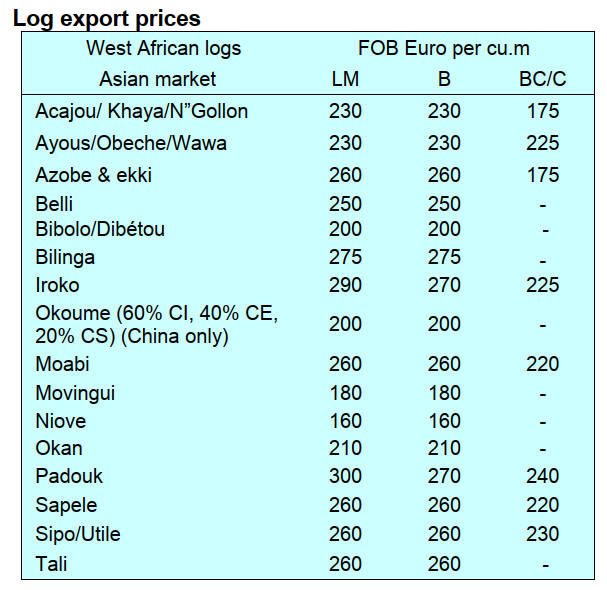
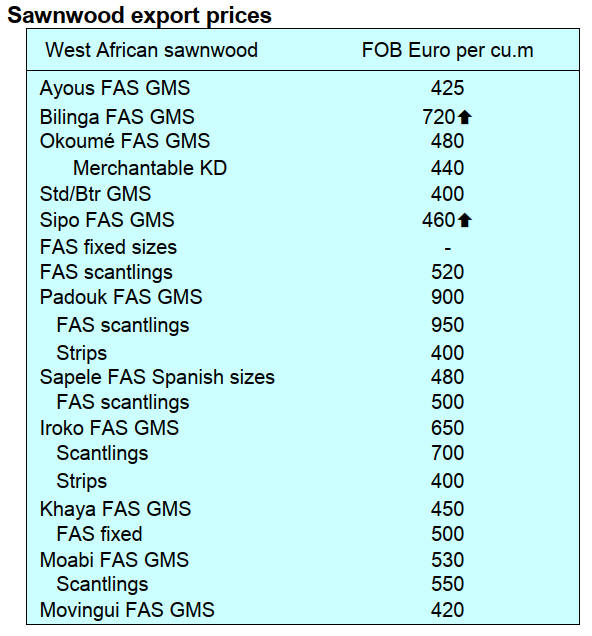
Through the eyes of industry
The latest GTI report lists the challenges identified by the private
sector in the Republic of Congo and Gabon.
See:
https://www.itto-ggsc.org/static/upload/file/20240116/1705365254170310.pdf
2.
GHANA
IMF support to boost growth
The Executive Board of the International Monetary Fund
(IMF) has approved a US$600 million loan facility to
support Ghana’s economic growth.
At a press conference with the IMF the Finance Minister,
Ken Ofori-Atta, described the development as a “pivotal
milestone” in the country’s economic programme
implementation.
The Governor of the Bank of Ghana (BoG), Dr. Ernest
Addison, said the government would continue to
implement sound policies to further ease inflation.
Stephane Roudet, IMF Mission Chief for Ghana said,
despite the difficult economic environment ongoing
reforms had started bearing fruit with signs of economic
stabilisation.
See:
https://mofep.gov.gh/news-and-events/2022-01-22/ghanas-secures-second-tranche-of-imf-us%24600m-for-disbursement
Billet and boule exports plunged in 2023
According the Ghana Forestry Commission Timber
Industry Development Division the volume of Ghana’s
wood product exports for the period January to October
2023 totalled 249,799 cu.m, a 15% shortfall when
compared to the 293,448 cu.m exported in the same period
in 2022.
The January to October 2023 exports earned Eur114.06
million compared to the Eur129.46 million in 2022, a
decrease of 12%. There were seventeen different wood
products exported.
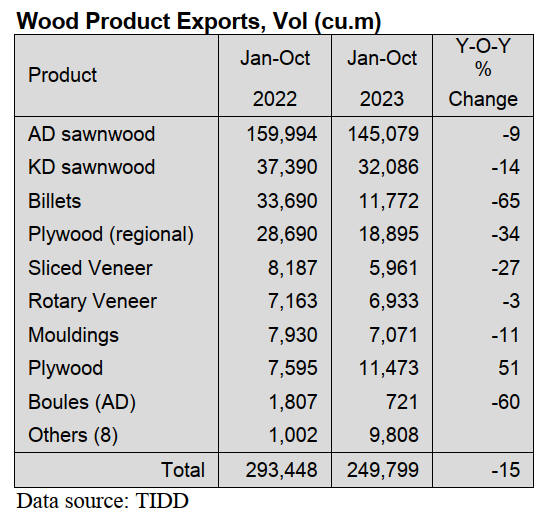
Exports of most wood products fell in the first 10 months
of 2023 with billets and air-dried boules plunging by 65%
and 60% respectively. Billet export volumes dropped to
11,772 cu.m from 2022 year on year a volume of 33,690
cu.m. Air-dried boule exports also dipped from 1,807cu.m
in 2022, to 721cu.m in 2023.
Billets and air-dried boules are primary products and
export volumes, as a percentage of the total export of
primary products, dropped to 7% in 2023, from 18% in
2022. The major species for these products were teak,
gmelina and niangon. The markets for these products
included India, Vietnam, Togo, Germany and the US.
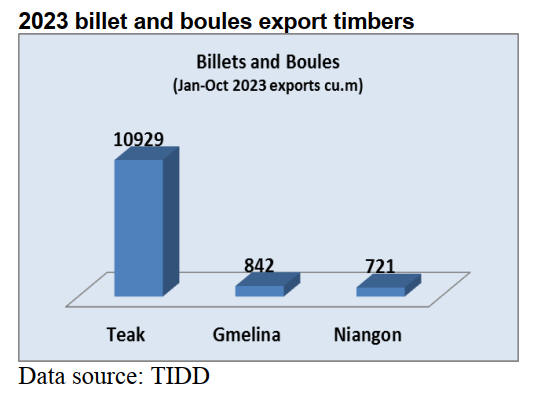
New plant tissue culture laboratory
Ghana has commissioned a plant tissue culture laboratory
established by by Star Agro Forestry Ghana Limited, a
commercial forest plantation developer in the Ashanti
region. The Deputy Minister of Lands and Natural
Resources, Mr. Benito Owusu-Bio, who commissioned the
facility, gave an overview of the Government’s
commitment to partnering with the private sector in forest
restoration activities.
The Chief Executive of Forestry Commission (FC), Mr.
John Allotey, on his part said tree seedlings to be produced
from the tissue culture laboratory will speed up production
of quality planting stock.
The Managing Director of Star Agro Forestry, Mr. Sanjay
Poddar, asked for the Commission’s maximum support for
its smooth operations. He expressed the determination of
his team to embark on a ground-breaking journey in
bringing cutting-edge technology to the heart of Ghana’s
forestry efforts.
D.Invitro Labs Ghana Ltd, in the Volta Region was the
first plant tissue culture laboratory in Ghana. A subsidiary
of SBW BV, a Dutch international group, started its
research in 1976.
See:
https://fcghana.org/plant-tissue-culture-laboratory-commissioned-in-the-ashanti-region/
Investment in forest restoration
The Deputy Minister of Lands and Natural Resources,
Benito Owusu Bio, has stated that a total of 728,609
hectares of degraded lands in Ghana have been restored
since 2017 which has been the greatest investments in
recent times by Government and the private sector in the
forest restoration activities.
In 2013 the land restoration programme covered 132,262
hectares through the Forest Plantation Development
Strategy, 25,342 hectares through enrichment planting and
571,005 hectares through planting within farms.
The Minister said the government’s afforestation
programme is within the framework of the Ghana Forest
Plantation Strategy (2017) and the Green Ghana Project
(2021). According to the Minister, the benefits from the
restoration programme included protection of watersheds,
job creation and support to national and global efforts
aimed at addressing climate change.
See:
https://gna.org.gh/2024/01/ghana-restores-728608-hectare-degraded-lands-within-seven-years-owusu-bio/
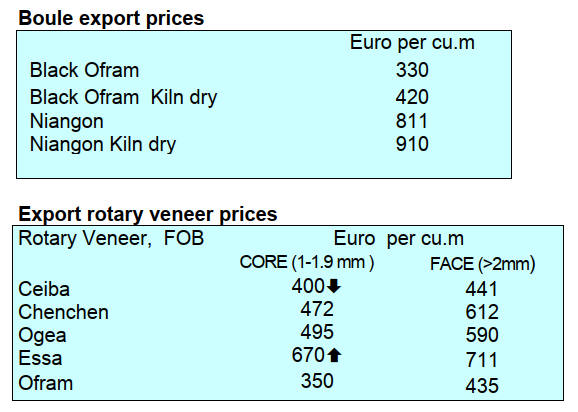 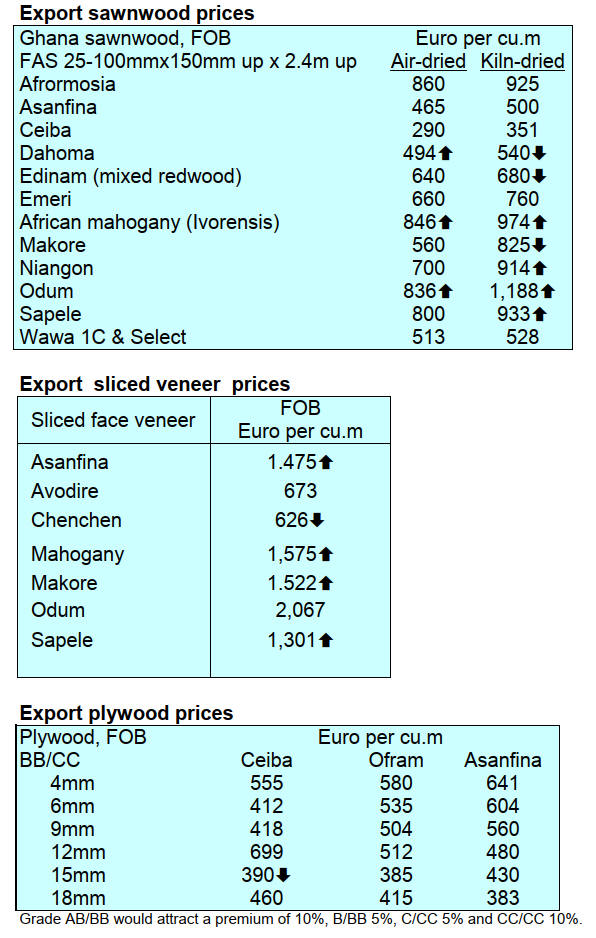
3. MALAYSIA
Exports expected to rebound
RHB Investment Bank (RHBIB) has maintained its
projection that Malaysia's GDP will grow by over 4% in
2024 with growth accelerating driven by stronger
international demand. Export growth is projected to
rebound in contrast to the decline of 8% in 2023. Domestic
consumption is forecast to improve.
Despite the challenging global economic situation last year
the trade surplus exceeded RM2 trillion for the third
consecutive year and has sustained a surplus for 26
successive years according to the Ministry of Investment,
Trade and Industry. In related news, Bank Negara
Malaysia maintained it 3% interest rate.
See:
https://www.thestar.com.my/business/business-news/2024/01/20/malaysia039s-gdp-growth-set-to-accelerate-to-46-in-2024---rhb-ib
And
https://theborneopost.pressreader.com/article/282123526371147
Sarawak timber exports drop
The value of wood product exports from Sarawak dropped
to RM3.1 billion in 2023 from RM3.9 billion in 2022. The
export value of logs stood at RM559 million or 18% of the
overall export value.
Japan remained the primary market for Sarawak’s wood
products accounting for 53% or RM1.7 billion of
Sarawak’s export earnings in 2023. Plywood remained
Sarawak’s main export product making up 48% of total
wood product export earnings.
Calls continue for a transformation of the sector and the
production of high value-added products utilising raw
material from planted forests. To achieve this
transformation the state government is committed to
strengthening the downstream industry, expanding into
biomass, furniture, bamboo and engineered wood.
Biomass products, such as wood pellets, biochar, and
charcoal briquettes have potential in establishing a green
economy in Sarawak. Wood pellets are exported to Japan,
France and Korea and were worth RM36 million in 2023.
In a bid to further diversify the industry Sarawak Timber
Industry Development Corporation STIDC is focusing on
developing the bamboo sector. Despite the global export
value of bamboo products reaching US$66.2 billion in
2022 Sarawak’s export market value was recorded at only
RM 1.2 million.
See:https://theborneopost.pressreader.com/article/281608130303400
Private sector collaboration on tree plantation
operations
The Sarawak Timber Industry Development Corp.
(STIDC) and the Malaysian Panel-Products
Manufacturers’ Association (MPMA) have signed a
memorandum to promote collaboration and knowledge
exchange on sustainable planted forest management
practices within the STIDC’s Licence for Planted Forests
(LPF/0043) project.
Both STIDC and MPMA acknowledge the growing need
for sustainable forest management practices as well as the
importance of research and development in the timber
industry. The chairman of MPMA, Sheikh Othman
Rahman, said the MoU would allow plywood
manufacturers to appreciate the importance of forest
management and industrial tree plantations as source of
raw material.
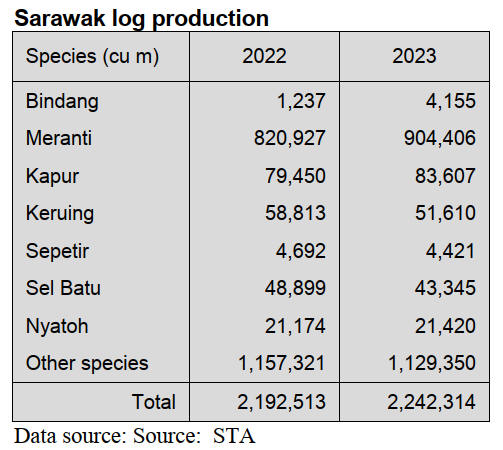
COVID cases surge
In the face of rising case numbers Malaysia has reactivated
the Covid Heightened Alert System, an early intervention
protocol based on the infection and death levels as well as
the hospitalisation rate to better monitor and appropriately
respond to infections. Singapore, Thailand and Indonesia
have issued advisories asking people to mask up and get
vaccinated.
The number of cases has shot up as much as 75% in these
countries since the start of January pushing case numbers
into the tens of thousands.
See:
https://asia.nikkei.com/Spotlight/Coronavirus/Malaysia-and-Singapore-put-guard-up-as-COVID-cases-surge
Through the eyes of industry
The latest GTI report lists the challenges identified by the
private sector in Malaysia.
See:
https://www.itto-ggsc.org/static/upload/file/20240116/1705365254170310.pdf
4.
INDONESIA
Pursuing 2024 furniture export target
The Indonesian Furniture and Crafts Industry Association
(HIMKI) noted that furniture and crafts exports in 2023
have likely fallen short of the target by almost 30%. A
number of steps have been taken to strengthen the export
performance this year. Abdul Sobur of the HIMKI
explained that there are several steps that must be taken to
achieve the 2024 export target of US$5 billion. According
to Abdul action is needed to ensure the availability of
quality raw materials.
Raw material price stability is a determining factor in the
competitiveness of the furniture and crafts industry. At
present it is estimated that around 30% of raw material
supplies are imported due to the lack of domestic supplies.
Abdul estimates that the equivalent of 12 million cubic
metres of roundwood will be required in 2024.
Apart from that, Abdul said that around 67,000 tonnes of
ready-to-use rattan raw material will be needed to meet the
export target of US$5 billion.
In related news, the Indonesian Furniture Industry and
Handicrafts Association (ASMINDO) has prepared a
roadmap to guide the national furniture and crafts industry
in the face of current challenges. The roadmap aims to
enhance export potential and strengthen domestic market
promotion. ASMINDO’s chairman, Dedy Rochimat,
disclosed that the global furniture market has continued to
grow, reaching a total transaction value of US$729 billion
last year.
“In 2023, the Asian market for furniture reached US$169
billion with the ASEAN region contributing US$13.7
billion” said Dedy.
ASMINDO aims to increase the development of the
national furniture and crafts industry through effective
work programmes that can have a significant impact, he
said, and export markets would be expanded beyond
America and Europe to new markets for example, Saudi
Arabia and Brazil.
See:https://forestinsights.id/rebut-pasar-furnitur-domestik-dan-ekspor-asmindo-siapkan-roadmap/
https://bisnis.solopos.com/ekspor-mebel-turun-pada-2023-ini-langkah-himki-kejar-target-2024-1844544
Plywood ready for export to the Philippines
A small quantity plywood made in South Kalimantan
recently secured a certificate from the South Kalimantan
Animal, Fish and Plant Quarantine office in advance of
shipment to the Philippines. Quarantine official, Aspul
Anwar, explained that the required documents from the
destination country were completed. He noted "for
physical inspection, plywood must be free from pest
organisms or quarantine plant pest organisms in the form
of wood boring insects and other live insects”.
See:https://www.riliskalimantan.com/2024/01/kayu-lapis-asal-kalsel-siap-berlayar-ke.html
Forest management challenges becoming more
complex
The Minister of Environment and Forestry, Siti Nurbaya,
ha said this year environmental and forest management
challenges will become increasingly complex and will
require administrative procedures that are consistent with
the needs of communities.
According to the Minister, governance success can no
longer be solely measured by administrative correctness.
The community must also benefit from the results and that
"bureaucratic work should be more closely related to
society.
In related news, the Minister stated that collaboration
between the government and all stakeholders is crucial in
taking effective measures to tackle climate change. The
government is continuing to encourage community
participation in actions to mitigate and adapt to climate
change starting from energy efficiency to forest and land
fire prevention.
See:
https://forestinsights.id/tantangan-makin-kompleks-menteri-siti-tegaskan-kerja-klhk-harus-terukur-dan-dirasakan-masyarakat/
https://en.antaranews.com/amp/news/302997/govt-invites-commmunity-to-participate-in-climate-action
Forest rangers monitoring capacity
The Deputy Minister of Environment and Forestry, Alue
Dohong, called on members of the Quick Reaction Forest
Ranger Unit, or SPORC, to improve their capacity to
monitor forests in Indonesia.
He remarked that the monitoring of territory by SPORC's
intelligence members aims to prevent potential threats
from turning into incidents, such as illegal logging,
encroachment, fires, hunting and social conflicts which
can have a damaging effect on the function of forests.
According to Dohong, SPORC forest rangers should have
the ability to supervise the condition and dynamics of
forests, identify potential problems and find appropriate
strategies and steps to overcome various forestry and
environmental problems.
See:
https://en.antaranews.com/news/303327/forest-rangers-should-step-up-monitoring-capacity-deputy-minister
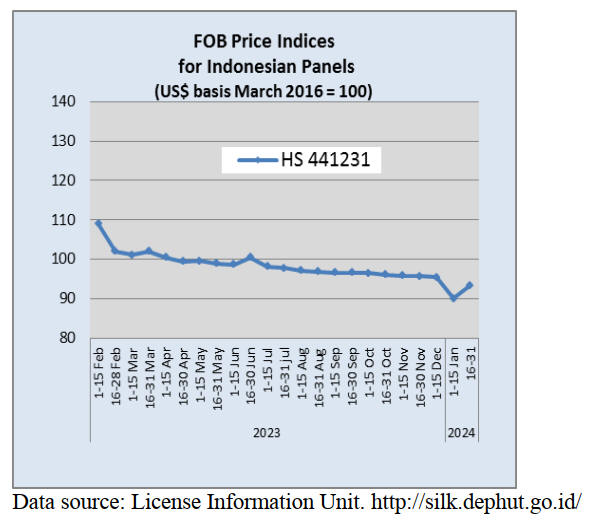
Through the eyes of industry
The latest GTI report lists the challenges identified by the
private sector in Indonesia.
See:
https://www.itto-ggsc.org/static/upload/file/20240116/1705365254170310.pdf
5.
MYANMAR
Outturn percentage set for plantation teak milling
According to the Facebook page of Wood Based Furniture
Association the Ministry of Natural Resources and
Environmental Conservation (MONREC) issued a
notification on the specification limit and the maximum
outturn percentage for the sawn timber which are to be
produced from teak thinning poles and posts. Details are
shown in the following tables.
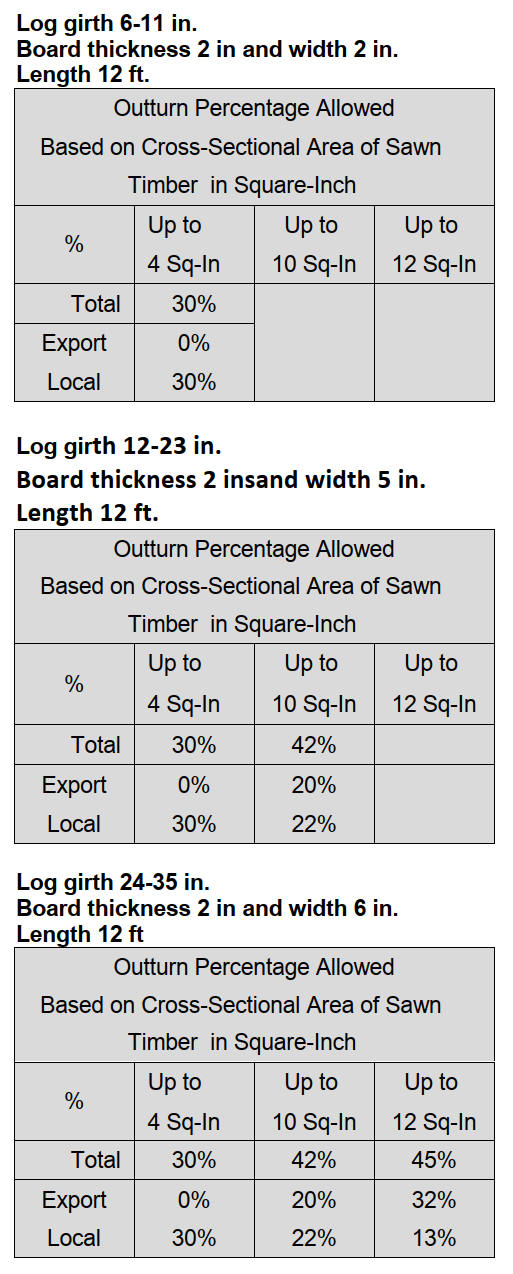
According to the notification the maximum size allowed
for export is 2inch in thickness, 6-inch in width and 12
feet in length. However, depending on the log girth the
maximum width and outturn percentage is variable.
For logs with a girth of 6-11 inches the maximum width is
2 inch and export is not allowed. For logs with a girth of
12-23 inches and 24-35 inches the maximum width is 5
and 6 inches respectively. The outturn percentage for
width 5 inch is 42% and for width 6 inch is 45%.
It is understandable that the setting of outturn limits is
aimed at preventing false outturns percentage which may
create the loophole under which the sawn timber from
natural forest teak can be substituted.
It's important to note that the notification does not cover
wood chips and pellets. In the case of logs from natural
forests there is a similar control on the maximum outturn
percentage. However, millers have the opportunity for an
exception known as Customised Cutting Approval.
Through this method millers can demonstrate the actual
cutting results using sample logs of random qualities
allowing for the approval of a higher outturn percentage.
The notification appears to be primarily targeted at private
plantations as logs from state-owned plantations offered in
MTE Tender sale, are typically over 30 years of age and
the same regulation is applied as to the logs from the
natural forest.
See:
https://myanmarforestcertification.org/wp-content/uploads/2021/01/Plantation-Extraction-Procedure_ENG.pdf.
Central Bank sells foreign currency
Myanmar's central bank has decided to inject over US$200
million worth of foreign currency into the forex market
to control inflation that it says is caused by soaring fuel
prices. This was done after CBM suspended the subsidised
facility to the fuel importer at the official rate of 2100
KYATs. The CBM sold US$19 million in December 2023
and US$53 million in January 2024 primarily directed
toward fuel importers.
Despite this fuel prices have surged by 12 to 15% since
December 2023. The CBM also sold 250 Million Thai
Baht in January and extended a SWAP facility equivalent
to US$4 million in Chinese yuan. Myanmar's heavy
reliance on China and Thailand for most commodities
through border trade underscores the significance of these
financial transactions. Concurrently, the market exchange
rate experienced an increase from 3350 to 3500 Kyats
against US dollar.
The central bank has frequently sold dollars to defend its
currency but this marks the first intervention of over
US$100 million. The kyat has depreciated by nearly 40%
since the beginning of August.
See:
https://asia.nikkei.com/Spotlight/Myanmar-Crisis/Myanmar-plans-200m-currency-intervention-to-fight-inflation
World Bank - worsening economic conditions
The World Bank's latest report on Myanmar acknowledges
the worsening conditions exacerbated by armed conflict
since October 2023, disrupting lives, livelihoods and
major trade routes. The Bank says the economic outlook is
bleak, with those signs of recovery observed in the first
half of 2023 proving fragile and short-lived.
See:
https://www.worldbank.org/en/news/press-release/2023/12/12/economic-recovery-falters-as-conflict-and-inflation-weigh
6.
INDIA
Housing demand set to
rise in urban and rural areas
CREDAI, in collaboration with Liases Foras, has
published a report that suggests housing demand in India
could reach 93 million homes by 2036, driven by growth
in key parameters including population in both urban and
rural areas, healthy macro-economic indicators and
favorable demographics, with several Tier II, III cities
projected to spearhead both demand and supply. With
Government programmes to establish Smart Cities, along
with increasing commercialisation activities in emerging
areas, it is widely expected that the next wave of real
estate growth will stem from Tier II, III regions.
The report was released at the New India Summit
organised by Confederation of Real Estate Developers’
Associations of India, (CREDAI) in Varanasi recently.
India has been the world’s fastest-growing major economy
in the last two years and is forecast to retain the top spot in
2024 as the urbanisation and industrialisation process
reaches the rapid take-off phase.
The Indian economy is projected to grow 6.2% in 2024
slightly lower than the 6.3 % estimate for 2023, amid
robust domestic demand and strong growth in the
manufacturing and services sectors, according to a UN
report. It also forecast that the global growth is set to 2.4%
in 2024 from an estimated 2.7% in 2023.
See:
https://www.constructionweekonline.in/business/indias-housing-demand-expected-to-skyrocket-to-93mn-by-2036-credai-liases-fora
Per capita panel product consumption set to rise
The ITTO correspondent in India writes “markets are
stable as is the exchange rate. India has a huge demand for
furniture and wood-based panel products because of the
growing economy. The per capita consumption of panel
products is much lower than in other countries but it will
grow with improving purchasing power.
Over the past 4 years the plantation timber based industry
has expanded its manufacturing capacity. Plywood, MDF,
OSB and Particleboard industries have increased their
capacity and seen healthy growth”.
Plyreporter says in its latest issu, with rising demand for
properties the demand for quality calibrated plywood and
panel products has also risen significantly but the high
timber cost has become an obstacle for expansion.
The positive sentiment among potential home buyers is
driving home sales and indirectly the demand for
calibrated plywood for use in manufacturing. A recent
survey suggests the consumption of quality plywood will
surge in the coming years due to demand led by architects,
interior designers and builders.
See:
https://www.liasesforas.com/admin/WhitePaper/56/WhitePaper_2023-12-06_63837473649630.pdf
Expanding plantations
Plyreporter has published information from the Ministry of
Environment, Forests and Climate Change. An official
notification in November announces the approval for tree
plantations to be established on areas designated as forest.
The raising of plantations by the Government Department
on the land recorded as forest in the Government records
shall be considered as forestry activity and accordingly,
provisions of the compensatory afforestation and Net
Present Value shall not be applicable for such plantation
activities.
While, the raising of commercial plantations of short
rotation, including plantation of medicinal plants in the
forest land shall be considered as non-forestry activities
and in such cases prior approval of the Central
Government shall be obtained and decision on such
proposals will be undertaken by them on the merits of
such case.
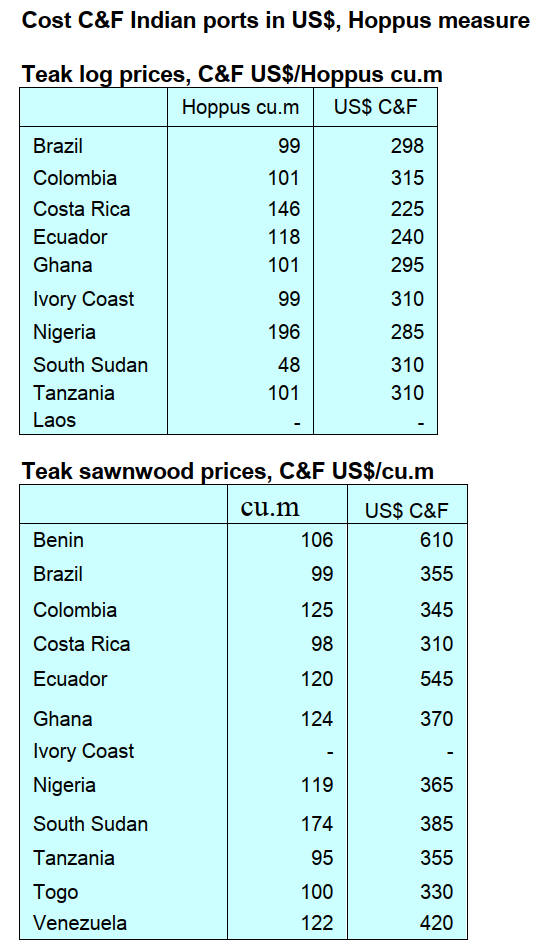

7.
VIETNAM
Wood and wood product (W&WP) trade Highlights
According to the General Department of Customs
Vietnam’s W&WP exports to the UK in December 2023
were recorded at US$20.9 million, down 22% compared to
December 2022. In 2023 the W&WP exports to the UK
were valued at US$195 million, down 19% compared to
2022.
Vietnam's office furniture exports in December 2023
accounted to US$24.4 million, down 13% compared to
December 2022. In 2023 office furniture exports
contributed US$267.9 million, down 28% compared to
2022.
The volume of tali imported in December 2023 stood at
26,700 cu.m, worth US$10.0 million, down 8% in volume
and 8% in value compared to November 2023. Compared
to December 2022, the volume fell by 54% in volume and
57% in value. In 2023 tali imports amounted to 378,200
cu.m, worth US$154.8 million, down 32% in volume and
32% in value compared to 2022.
Imports of logs and sawnwood from Southeast Asia in
December 2023 are estimated at 80,000 cu.m with a value
of US$22.0 million, down 0.4% in volume but up 2.2% in
value compared to November 2023 bringing the total
amount of imports from these suppliers to 838,80 cu.m at
a value of US$231.99 million, down 7% in volume and
23% in value compared to 2022.
In December 2023, W&WP exports amounted to US$1.3
billion, up 10% compared to November 2023 and up 2%
compared to December 2022. In particular, WP exports
reached US$952.6 million, up 10% compared to
November 2023 and up 9% compared to December 2022.
In 2023, W&WP exports totalled at US$13.5 billion, down
16% compared to 2022.
Vietnam's W&WP exports to South Korea in December
2023 reached US$66.4 million, down 33% compared to
December 2022. Generally, in 2023 W&WP exports to
South Korea stood at US$784.3 million, down 23.4%
compared to 2022.
In December 2023 exports of kitchen furniture reached
US$122 million, up 17% compared to December 2022.
Overall, in 2023 exports of kitchen furniture contributed
US$1.19 billion, down 10% compared to 2022.
Vietnam's oak imports in December 2023 were 25,700
cu.m, worth US$14.3 million, down 8% in volume and 8%
in value compared to November 2023. However,
compared to December 2022, import volumes increased
by 33% and 34% in value. In 2023 oak imports amounted
to 280,000 cu.m, worth US$154.7 million, down 2% in
volume and 16% in value compared to 2022.
Imports of logs and sawnwood from China in December
2023 were reported at 65,000 cu.m, at a value of US$25.0
million, down 2% in volume and 1% in value compared to
November 2023 bringing the total volume of wood
imported from China in 2023 to 569,030 cu.m at a value of
US$253 million, down 13% in volume and 28% in value
compared to 2022.
Certification could spur exports
The strict Forest Stewardship Council certification
regulations pose both challenges and opportunities for the
Vietnamese timber industry.
One of the largest retailers in the United States, is seeking
to procure FSC certified wood products from Vietnam.
Vietnam has seen increased demand for FSC-certified
timber materials due to requirements from import markets,
the largest of which are the US and Europe.
However, there are challenges regarding FSC
requirements on verification of the origin wood raw
materials used in manufacturing.
Vietnam primarily purchases FSC wood from South
American and African countries but transport is expensive
and takes a considerable time.
In recent years, the Vietnamese government has
introduced policies such as the Vietnam Forestry
Development Strategy 2021–2030 and a scheme to
develop a sustainable and effective wood processing
industry which promotes the growth of plantations of large
size logs with FSC certification.
As a consequence, an increasing number of companies
operating in the timber processing sector are actively
pursuing prospects for direct involvement in the certified
forest supply chain. A number of companies, including
Woodsland, NAFOCO, and Scancia Pacific have achieved
raw material self-sufficiency it has been reported.
Woodsland Tuyen Quang, an enterprise that manufactures
interior and exterior wood products for IKEA Group, has
collaborated with five forestry companies in the northern
province of Tuyen Quang since 2015 to secure certified
raw material.
According to the company’s president, Do Thi Bach
Tuyet, the company is engaged in collaboration with
forestry firms and domestic organisations to formulate a
forest management strategy spanning a minimum of seven
years with the objective of establishing timber material
areas that satisfy processing requirements.
Vu Thi Que Anh, the FSC representative in Vietnam,
remarked that the ability to access more developed global
markets is one of the greatest benefits for forest owners in
Vietnam through obtaining FSC certification.
According to Que Anh the proportion of forested land in
Vietnam with FSC certification has reportedly increased in
recent years.
The FSC-certified forest area in Vietnam is projected to
extend to around 282,960 ha, representing 64% of the
country’s total planted forest area.
See:
https://vietnamnet.vn/en/vietnam-business-news-january-16-2024-2238964.html
8. BRAZIL
Major investment in
reforestation in Latin America
The Development Bank of Latin America and the
Caribbean (CAF) has announced an investment of US$25
million in Timberland Investment Group's (TIG)
reforestation strategy in Latin America.
TIG, a subsidiary of BTG Pactual, aims to protect and
restore around 150,000 hectares of deforested natural
forests in Brazil, Uruguay and Chile.
The initiative also aims to create sustainable and
independently certified commercial forests to improve
biodiversity and support inclusive community
development.
In line with its mission to boost sustainable development,
CAF aims to become the region's green bank committing
to allocate US$25 billion in green financing by 2026
representing an increase from 24% to 40% of total
approvals.
See:
https://www.remade.com.br/noticias/19710/caf-investe-us$-25-milhoes-em-reflorestamento-na-america-latina
Forest sector goals for 2024 in Mato Grosso State
During a meeting of the forest sector in Alta Floresta,
State of Mato Grosso in the Amazon Region, members of
the forest industry discussed topics such as market
expansion, sectoral policies, associations and health and
safety issues.
The meeting was attended by more than 60 entrepreneurs
from the forest sector who work in the municipalities that
make up Simenorte's union led by representatives of the
Mato Grosso Timber Producing and Exporting Industries
Center (CIPEM). They highlighted the importance of
business association to explore new markets and
achievements such as the inclusion of forest management
plans in credit lines.
In addition, the extension of the validity of logging
permits from 12 to 24 months was highlighted as a
breakthrough.
CIPEM pointed out that the municipalities in the north of
Mato Grosso are important producers of "legal, traceable
and certified" timber from natural forests and emphasised
the importance of business alliances to conduct
negotiations as a bloc and seeking new markets and
improvements for forest-based activities.
FIEMT (Federation of Industries in the State of Mato
Grosso) emphasised the role of associations in
strengthening agroindustry, highlighting the benefits of
sustainable socio-economic development. The State
Environment Secretariat (Sema) stressed the importance of
Sustainable Forest Management Plans in Mato Grosso,
highlighting efforts to integrate State requirements with
the production sector.
The National Forum for Forest-Based Activities (FNBF)
pointed out that timber is the main economic activity in
33% of Mato Grosso's municipalities and FNBF
encourages access to new markets and highlights the
strengthening of alliances as a key to balancing sectoral
policies.
See:
https://cipem.org.br/noticias/metas-para-2024-sao-debatidas-por-empresarios-da-industria-florestal-em-assembleia-no-extremo-norte-de-mt
Export update November 2023
In November 2023, Brazilian exports of wood-based
products (except pulp and paper) decreased 6.8% in value
compared to November 2022, from US$276.8 million to
US$258.0 million.
Pine sawnwood exports dropped 18% in value between
November 2022 (US$55.9 million) and November 2023
(US$45.8 million). In volume, exports declined 7% over
the same period, from 214,200 cu.m to 199,700 cu.m.
Tropical sawnwood exports fell 21% in volume, from
23,200 cu.m in November 2022 to 18,400 cu.m in
November 2023. In value, exports decreased 38% from
US$13.3 million to US$8.3 million over the same period.
In contrast, pine plywood exports increased 14% in value
in November 2023 compared to November 2022, from
US$44.2 million to US$50.2 million. In volume, exports
increased 18% over the same period, from 136,300 cu.m
to 160,900 cu.m.
As for tropical plywood, exports also increased in volume
by 33% and in value by 27%, from 1,800 cu.m and
US$1.1 million in November 2022 to 2,400 cu.m and
US$1.4 million in November 2023, respectively.
As for wooden furniture the exported value decreased
from US$52.0 million in November 2022 to US$49.3
million in November 2023, a 5% fall in the total.
Export update December 2023
In December 2023, Brazilian exports of wood-based
products (except pulp and paper) increased 2% in value
compared to December 2022, from US$270.8 million to
US$276.2 million.
Pine sawnwood exports increased 15% in value between
December 2022 (US$45.5 million) and December 2023
(US$52.3 million). In volume, exports increased 30% over
the same period, from 183,700 cu.m to 237,800 cu.m.
Tropical sawnwood exports also increased by 26% in
volume, from 17,500 cu.m in December 2022 to 22,100
cu.m in December 2023. However the value of these
exports decreased 10% from US$10.2 million to US$9.2
million over the same period.
Pine plywood exports rose 16% in value in December
2023 compared to December 2022, from US$43.4 million
to US$50.3 million. In volume, exports increased 22%
over the same period, from 135,600 cu.m to 165,700 cu.m.
Tropical plywood, exports declined in volume 28% and in
value by 8%, from 2,500 cu.m and US$1.2 million in
December 2022 to 1,800 cu.m and US$1.1 million in
December 2023.
As for wooden furniture, the exported value increased
from US$43.9 million in December 2022 to US$45.6
million in December 2023, an increase of around 4%.
Furniture exports - good prospects for 2024
Brazilian exports of furniture and mattresses grew by a
remarkable 10% in November 2023 compared to the
previous month, reaching an amount of US$68.5 million.
ABIMÓVEL (Brazilian Furniture Industry Association)
points out that this positive expansion has led to the view
that there may be better prospects for the furniture industry
in 2024.
An analysis conducted by IEMI reveals that the recent
increase in exports is not only influenced by the dynamics
of the Brazilian and global markets, but is also a direct
reflection of the strategies adopted by the Brazilian
furniture industry which is focused on innovation,
sustainable management and participation in international
events.
Projections for 2024 indicate a relevant cycle for the
Brazilian Furniture Project led by ABIMÓVEL in
partnership with ApexBrasil (Brazilian Trade and
Investment Promotion Agency). With around 150 member
companies exporting to 180 countries, the sector plans to
take part in high-profile events such as the Milan and New
York Design Weeks.
The initiative will focus on actions such as international
fairs and trade missions, highlighting the importance of
keeping up to date with the sector's indicators for effective
planning. The aim is to showcase dozens of Brazilian
brands in exhibitions to promote the best of Brazil.
See:
http://abimovel.com/exportacoes-de-moveis-e-colchoes-ganharam-forca-ao-final-do-ultimo-trimestre-trazendo-melhores-perspectivas-para-o-inicio-de-2024-2/
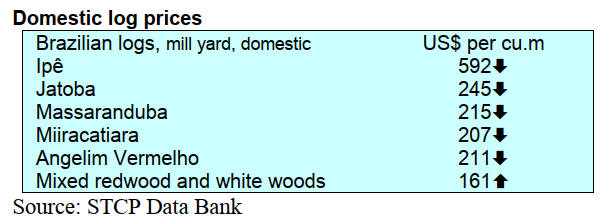
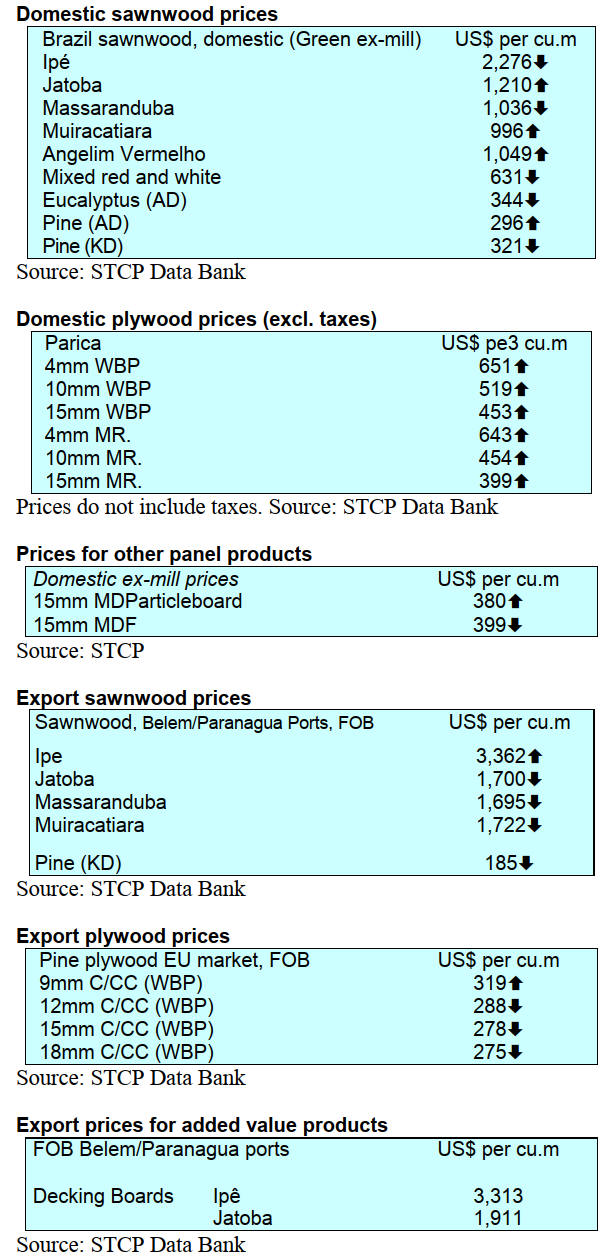
9. PERU
Veneer and plywood
exports disappoint
The Association of Exporters (ADEX) has reported export
shipments of veneer and plywood between January and
November 2023were worth US$2.25 million, a contraction
of 22.5% compared to the same period in 2022 when
exports earned US$2.90 million.
This fall is partly explained by lower demand from
Mexico, the main market in recent years, which went from
US$2.73 million in 2022 to US$1.92 million in 2023, a
drop of almost 30%.
According to data from the ADEX Data Trade
Commercial Intelligence System other export markets
were the Dominican Republic (US$0.19 million), Chile
(US$0.09 million), Ecuador (US$0.02 million) and the
United States (US$0.01 million).
Veneers and plywood represented 2.4% of the total wood
products exported by Peru between January and November
2023.
Action to strengthen forestry development
Representatives of the German Development Bank KfW
and leaders of the Sustainable Productive Forests (BPS)
programme recently met to coordinate a plan to strengthen
forestry development in the region. This initiative seeks to
ensure timely and effective progress of the programme.
The Regional Forestry and Wildlife Management also
participated in the meeting.
The German Development Bank, KfW, which co-finances
the BPS programme which aims to
strengthen the national forest sector with a focus on
sustainability and productivity.
Ucayali is one of the prioritised regions where there is a
focus of the programme because it is has alarge forest area
and a strategic location for the market. The aim is to
consolidate Ucayali as a center of forestry production and
as a timber hub in the Amazon.
At the meeting the BPS coordinator presented the new
heads of the Plantations, Forests and Planning projects.
They will work with regional and local governments. The
heads of the Forests and Planning Projects coordinated to
meet joint goals. In addition, the creation of Forest
Management Units and the acquisition of necessary
technology were discussed.
Training in forest inspection tasks
A group of 30 professionals have were trained to carry out
supervision and control of forest resources through a
specialisation course developed by the Forest and Wildlife
Resources Supervision Agency (OSINFOR) .
OSINFOR plans to train more than 900 professionals in
2024who will be deployed to control action in
approximately 683,592 hectares of forest.
As part of the course the professionals deepened their
knowledge in the supervision and inspection processes and
the use of OSINFOR digital tools and platforms.
See:
https://www.gob.pe/institucion/osinfor/noticias/889618-profesionales-supervisores-fortalecen-knowledges-para-realizar-labores-de-fiscalizacion-forestal-con-el-osinfor
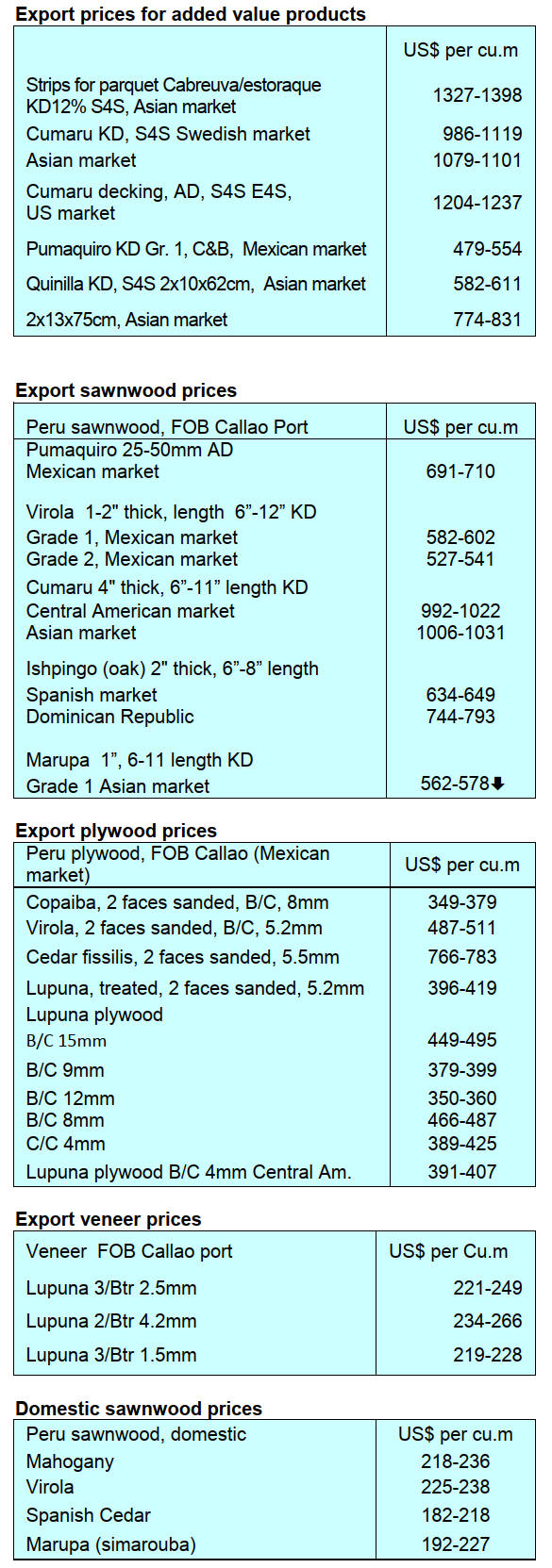
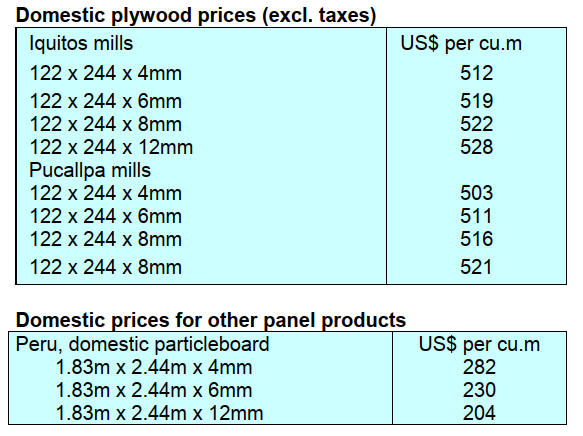
|